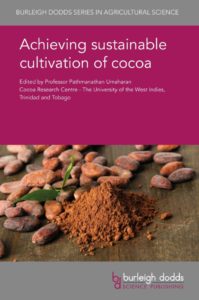With a distinguished editor and a variety of international experts as authors, including a number from the CGIAR Research Program on Forests, Trees and Agroforestry (FTA), Burleigh Dodds Science Publishing recently launched the book Achieving sustainable cultivation of cocoa, considered a new standard reference for scientists and producers of cocoa.
Eduardo Somarriba from the Agriculture, Livestock and Agroforestry Program (PRAGA) at CATIE (Tropical Agricultural Research and Higher Education Center) appears as a chapter author, while CATIE’s Rolando Cerda and Wilbert Phillips are coauthors.
Bioversity International’s Stephan Weise, Brigitte Laliberté and Jan Engels also contributed to the book. Meanwhile, the Agricultural Research Centre for International Development (CIRAD) saw a number of contributors across various chapters, namely Philippe Lachenaud, Didier Snoeck, Bernard Dubos, Leïla Bagny Beilhe, Régis Babin, Martijn ten Hoopen, Christian Cilas and Olivier Sounigo.
Read also: Achieving sustainable cultivation of cocoa
According to Francis Dodds, editorial director of Burleigh Dodds Science Publishing, the book discusses the existing challenges standing in the way of making cocoa crops more efficient and sustainable, in order to supply increasing demand, while taking into account the increasing age of plantations, decreasing performance and greater vulnerability to illnesses. At the same time, the authors heed increasing concerns about the environmental impact of cocoa on soil health and biodiversity.
The first part of the book looks at genetic resources and developments in production technologies. The second part discusses the optimization of crop techniques to take maximum advantage of the new varieties, while the third part summarizes recent research about the understanding of and fight against major viral and fungal diseases affecting cocoa. The fourth part covers security and quality issues, and finally the last part of the book analyzes ways to improve sustainability, including the role of agroforestry, organic crops, and ways to support small producers.

Notably, Somarriba and Philips contributed to the first and fifth sections of the book, with Somarriba addressing the issue of the analysis and design of the shade canopy of cocoa in agroforestry systems, and Phillips looking at the main challenges of conservation and exploiting cocoa genetic resources.
The book was edited by the recognized and cocoa expert, Pathmanathan Umahran, director of the Research Centre for Cocoa and professor of genetic at the University of the Occidental Indies, in Trinidad and Tobago.
Martin Gilmour, Director of Research and Sustainability Development of Cocoa at Mars Global Chocolate, stated in a press release from Burleigh Dodds Science Publishing that the book would be of great interest for researchers, development agencies, governments, specialists in the industry and non-government organizations, as well as anyone interested in improving cocoa crop sustainability.
Adapted from the article by CATIE communicator Karla Salazar Leiva, originally published by CATIE.
For more information, contact Karla Salazar Leiva at karla.salazar@catie.ac.cr or Eduardo Somarriba, Leader of CATIE’s Agriculture, Livestock and Agroforestry Program, at Eduardo.somarriba@catie.ac.cr.











